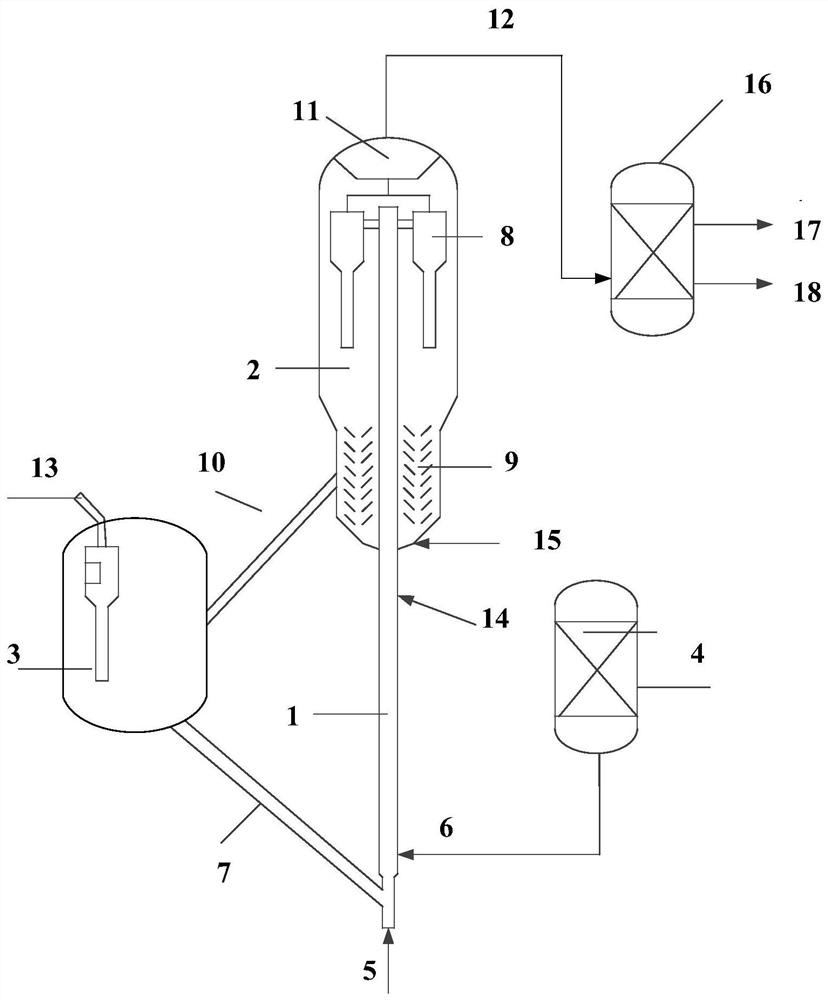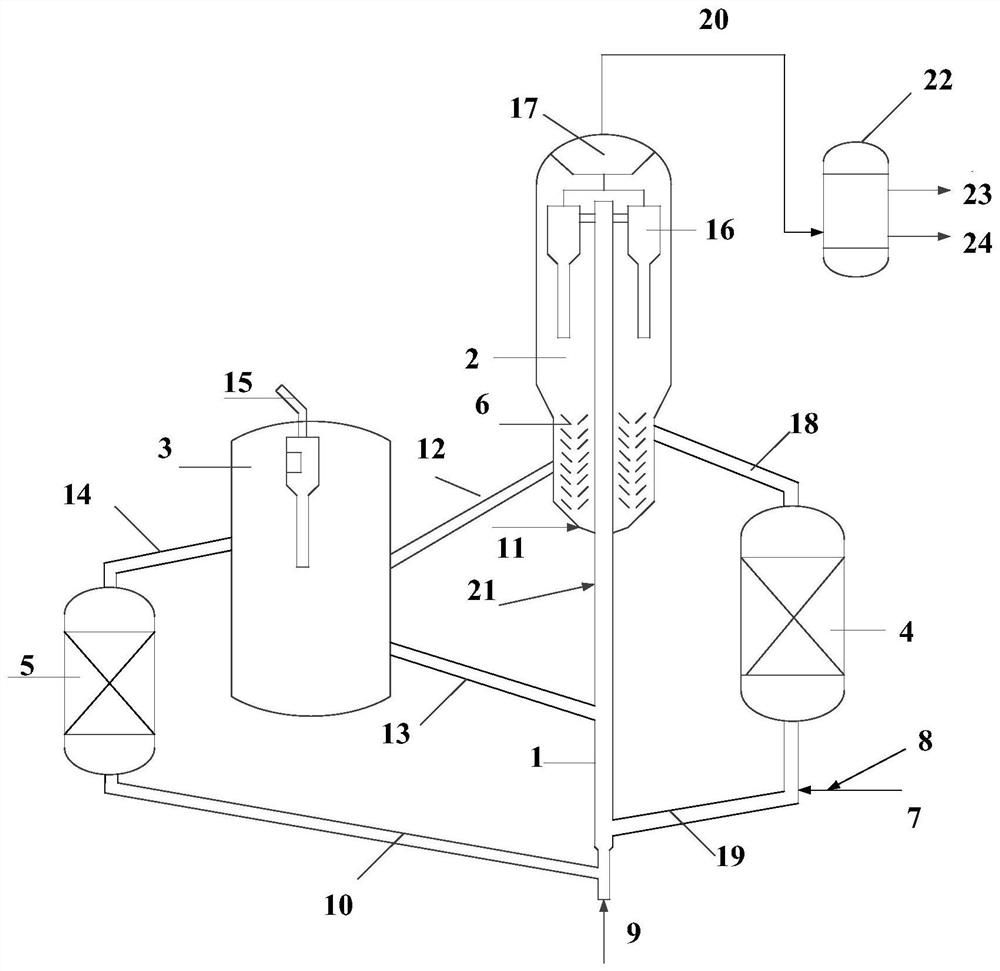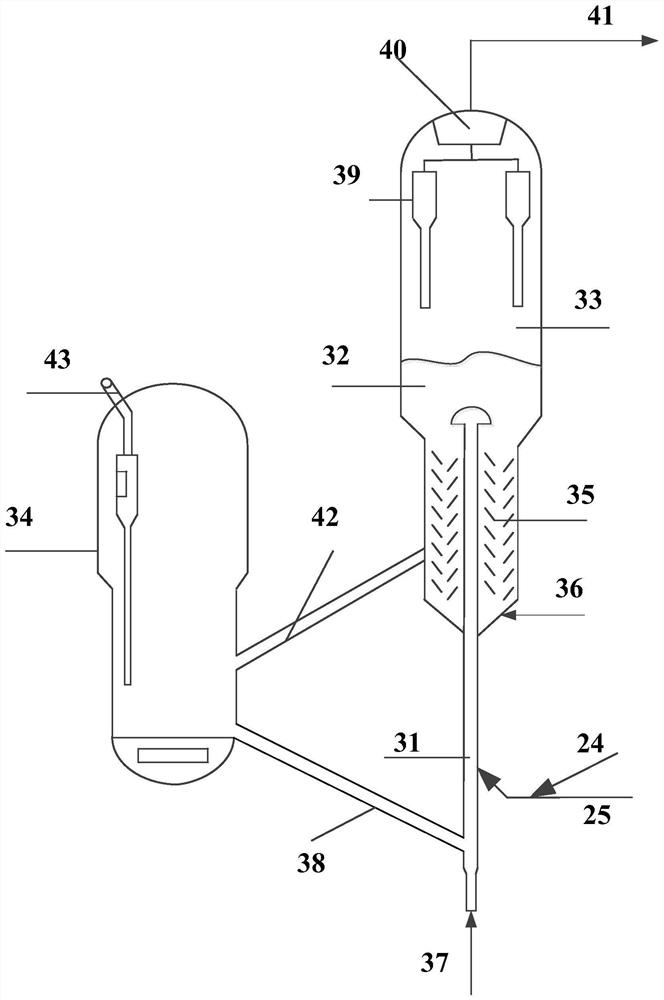Processing method and system of waste plastics
A technology for waste plastics and plastics, which is applied in the field of catalytic conversion methods and systems of waste plastics, can solve the problems of high construction cost of hazardous solid waste landfills, complex hydrogenation technology process, and high requirements for equipment materials, so as to improve the utilization value. , Solve equipment corrosion, solve the effect of high-efficiency value
- Summary
- Abstract
- Description
- Claims
- Application Information
AI Technical Summary
Problems solved by technology
Method used
Image
Examples
Embodiment 1
[0086] according to figure 1 The flow of the test is carried out, and the waste plastic catalytic decomposition reaction test is carried out on the medium-sized device of the riser reactor. The waste plastic mixture enters the lower part of the riser reactor, contacts with the hot industrial catalytic cracking unit waste catalyst, and carries out the catalytic decomposition reaction. In the reaction A dechlorination agent is injected into the lower part of the reactor. The amount of dechlorination agent is 2000 mg / kg of waste plastics. It reacts with the hydrogen chloride generated in the reactor. The reaction product and the catalyst to be produced enter the closed cyclone separator from the reactor outlet. The reaction product and The raw catalyst is quickly separated, and the reaction product is separated into cracked gas and plastic to generate oil in the separation system according to the distillation range. The separated gas is returned to the bottom of the riser reactor...
Embodiment 2
[0089] according to image 3 The process flow test is carried out on the medium-sized device of the riser and the dense phase fluidized bed series reactor, and the plastics generation oil catalytic conversion test is carried out. The plastics generation oil obtained in Example 1 enters the bottom of the riser reactor, and is mixed with hot DMMC- 2 Catalyst contact, and carry out catalytic conversion reaction, the reaction product and the catalyst go up and enter the dense phase fluidized bed reactor to continue the reaction, the reaction product and the unborn catalyst enter the closed cyclone separator from the outlet of the reactor, the reaction product and the unborn catalyst Rapid separation, the reaction product is separated into fractions such as dry gas, liquefied gas, gasoline and diesel in the separation system according to the distillation range, and the dry gas and liquefied gas are further separated into products such as ethylene, propylene and butene.
[0090] The...
Embodiment 3
[0099] according to figure 2 The test is carried out on the medium-sized device of the riser reactor. The raw material oil is a waste plastic mixture, and the catalyst is a waste catalyst of an industrial catalytic cracking unit. The waste plastic mixture is first contacted with a cold standby catalyst for melting and gasification And decomposition reaction, the reaction oil enters the bottom of the riser reactor to contact the cold regenerated catalyst and continue the decomposition reaction, the reaction oil moves up the reactor, and successively contacts the hot regenerated catalyst and dechlorination agent injected from the middle and downstream of the reactor And decomposition reaction and dechlorination reaction take place, the consumption of dechlorination agent is 2000 mg / kg, reacts with the chlorinated chlorine generated in the reactor, the reaction product and the unborn catalyst enter the closed cyclone separator from the reactor outlet, and the reaction product It...
PUM
 Login to View More
Login to View More Abstract
Description
Claims
Application Information
 Login to View More
Login to View More - R&D
- Intellectual Property
- Life Sciences
- Materials
- Tech Scout
- Unparalleled Data Quality
- Higher Quality Content
- 60% Fewer Hallucinations
Browse by: Latest US Patents, China's latest patents, Technical Efficacy Thesaurus, Application Domain, Technology Topic, Popular Technical Reports.
© 2025 PatSnap. All rights reserved.Legal|Privacy policy|Modern Slavery Act Transparency Statement|Sitemap|About US| Contact US: help@patsnap.com



